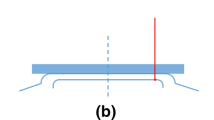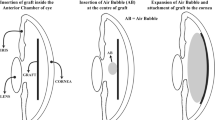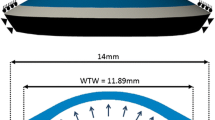Abstract
Keratoplasty, which is cornea transplant surgery, is one of the treatment methods for patients with turbidity or keratitis. Recently, keratoplasty using a surgical robot was studied to increase precision. In this study, the effect of surgical factors on the deformation and curvature of the cornea were analyzed in order to improve the accuracy of keratoplasty and derive the optimal surgical factors using finite element method (FEM). Suturing tension and depth were selected as surgical factors. An FEM model, a constitutive equation, and boundary conditions were determined using experiments and reference data. Suturing tension significantly impacted deformation and curvature change, and suturing depth affected the position of the thread-cornea contact point. Both factors have a significant impact on a focal point in the retina and the patient’s visual acuity after keratoplasty.











Similar content being viewed by others
References
Melles GRJ. Posterior lamellar keratoplasty: DLEK to DSEK to DMEK. Cornea. 2006;25(8):879–81.
Hollick EJ, Coombes A, Perez-Santonja JJ, Dart JK. Lamellar keratoplasty and intracorneal inlay: an alternative to corneal tattooing and contact lenses for disfiguring corneal scars. Br J Ophthalmol. Video Report. 2005.
Hu Y, Li D, Zong G, Sun X. Robotic system for microsurgical keratoplasty. In: 27th Annual international conference of the IEEE engineering in medicine and biology society. 2005.
Zong G, Hu Y, Li D, Sun X. Visually servoed suturing for robotic microsurgical keratoplasty. In: IEEE/RSJ international conference on intelligent robots and systems. 2006.
Bourges JL, Hubschman JP, Burt B, Culjat M, Schwartz SD. Robotic microsurgery: corneal transplantation. Br J Ophthalmol. 2009;93(12):1672–5.
Hoeltzel DA, Altman P, Buzard K, Choe K. Strip extensiometry for comparison of the mechanical response of bovine, rabbit, and human corneas. J Biomech Eng. 1992;114(2):202–15.
Bryant MR, Szerenyi K, Schmotzer H, McDonnell PJ. Corneal tensile strength in fully healed radial keratotomy wounds. Invest Ophthalmol Vis Sci. 1994;35(7):3022–31.
Bryant MR, McDonnell PJ. Constitutive laws for biomechanical modeling of refractive surgery. J Biomech Eng. 1996;118(4):473–81.
Zeng Y, Yang J, Huang K, Lee Z, Lee X. A comparison of biomechanical properties between human and porcine cornea. J Biomech. 2001;34(4):533–7.
Elsheikh A, Anderson K. Comparative study of corneal strip extensometry and inflation tests. J R Soc Interface. 2005;2(3):177–85.
Elsheikh A, Wang D, Pye D. Determination of the modulus of elasticity of the human cornea. J Refract Surg. 2007;23(8):808–18.
Elsheikh A, Alhasso D, Rama P. Biomechanical properties of human and porcine corneas. Exp Eye Res. 2008;86(5):783–90.
Rawe IM, Meek KM, Leonard DW, Takahashi T, Cintron C. Structure of corneal scar tissue: an x-ray diffraction study. Biophys J. 1994;67(4):1743–8.
Newton RH, Meek KM. The integration of the corneal and limbal fibrils in the human eye. Biophys J. 1998;75(5):2508–12.
Boote C, Dennis S, Newton RH, Puri H, Meek KM. Collagen fibrils appear more closely packed in the prepupillary cornea: optical and biomechanical implications. Invest Ophthalmol Vis Sci. 2003;44(7):2941–8.
Anderson Kevin, El-Sheikh Ahmed, Newson Timothy. Application of structural analysis to the mechanical behaviour of the cornea. J R Soc Interface. 2004;1(1):3–15.
Studer H, Larrea X, Riedwyl H, Büchler P. Biomechanical model of human cornea based on stromal microstructure. J Biomech. 2010;43(5):836–42.
Pandolfi A, Manganiello F. A model for the human cornea: constitutive formulation and numerical analysis. Biomech Model Mechanobiol. 2006;5(4):237–46.
van Rij G, Waring GO. Changes in corneal curvature induced by sutures and incisions. Am J Ophthalmol. 1984;98(6):773–83.
Yang YF, Zhang J, Wang XH, Wang Q, Mei J, Zeng YJ. Simulation of Corneal tissue mechanical deformation due to laser thermokeratoplasty: a finite element methods study. Australas Phys Eng Sci Med. 2009;32(4):220–5.
Lanchares E, Calvo B, Cristòbal JA, Doblare M. Finite element simulation of arcuates for astigmatism correction. J Biomech. 2008;41:797–805.
Asrani S, Zeimer R, Wilensky J, Gieser D, Vitale S, Lindenmuth K. Large diurnal fluctuations in intraocular pressure are an independent risk factor in patients with glaucoma. J Glaucoma. 2000;9(2):134–42.
Jonas JB, Kreissig I, Degenring R. Intraocular pressure after intravitreal injection of triamcinolone acetonide. Br J Ophthalmol. 2003;87(1):24–7.
Gefen A, Shalom R, Elad D, Mandel Y. Biomechanical analysis of the keratoconic cornea. J Mech Behav Biomed Mater. 2009;2(3):224–36.
Elsheikh A. Finite element modeling of corneal biomechanical behavior. J Refract Surg. 2010;26(4):289–300.
Uchio E, Ohno S, Kudoh J, Aoki K, Kisielewicz LT. Simulation model of an eyeball based on finite element analysis on a supercomputer. Br J Ophthalmol. 1999;83(10):1106–11.
Jue B, Maurice D. The mechanical properties of the rabbit and human cornea. J Biomech. 1986;19(10):847–53.
Crabb RA, Chau EP, Evans MC, Barocas VH, Hubel A. Biomechanical and microstructural characteristics of a collagen film-based corneal stroma equivalent. Tissue Eng. 2006;12:1565–75.
Liu Y, Griffith M, Watsky MA, Forrester JV, Kuffova L, Grant D. Properties of porcine and recombinant human collagen matrices for optically clear tissue engineering applications. Biomacromol. 2006;7(6):1819–28.
Cho JH. Analysis of needle–tissue interaction for robotic corneal suturing. Master-degree thesis, POSTECH. 2016.
Acknowledgements
This work was supported by the Industrial Technology Innovation Program (No. 10048358) funded by the Ministry of Trade, Industry & Energy (MI, Korea).
Author information
Authors and Affiliations
Corresponding author
Ethics declarations
Conflict of interest
The authors declare that they have no conflict of interest.
Ethical Statement
This work does not contain any animal study.
Additional information
Publisher's Note
Springer Nature remains neutral with regard to jurisdictional claims in published maps and institutional affiliations.
Rights and permissions
About this article
Cite this article
Baek, J.W., Park, S.J. Finite element analysis of cornea deformation and curvature change during the keratoplasty suturing process. Biomed. Eng. Lett. 9, 203–209 (2019). https://doi.org/10.1007/s13534-019-00100-4
Received:
Revised:
Accepted:
Published:
Issue Date:
DOI: https://doi.org/10.1007/s13534-019-00100-4




